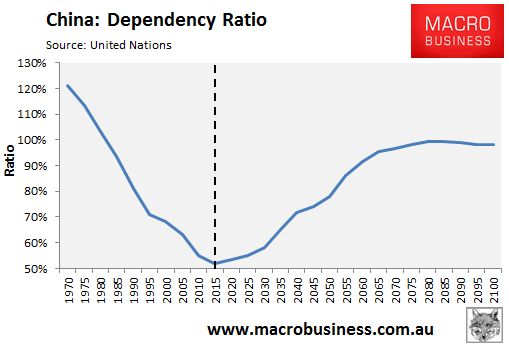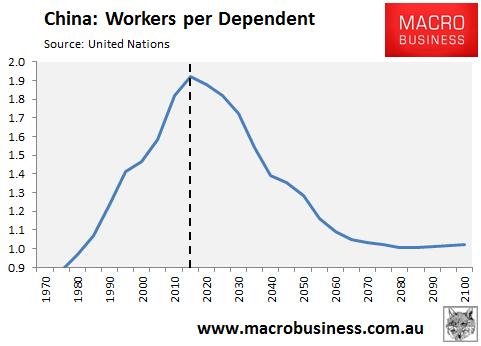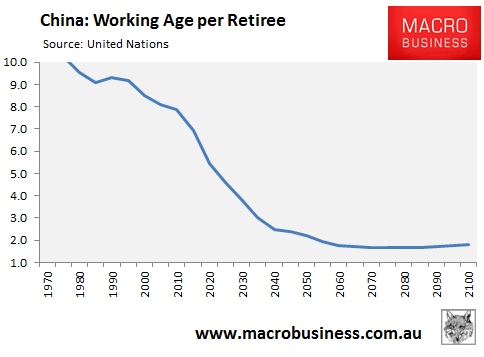I have noted previously how China’s economy will soon face still headwinds from an ageing population (see here, here, here, and here).
Essentially, China’s ageing problem stems from its ‘one child policy’, which was brought into effect in the early-1970s and is credited with preventing around 400 million births from 1979 to 2010. This policy initially produced a population pyramid optimal to economic growth – that is, where the largest segments of the population were neither young nor old, but in the middle (i.e. working age).
However, the demographic blessing provided by the one child policy has turned into a curse, with the United Nations forecasting that the number of working aged people to dependents is set to almost halve over the 50 years to 2065, from a peak of 1.9 workers to dependents in 2015 to only 1.0 by 2065 (see charts below).



In 2015, the Communist Party leadership belatedly ended the ‘one child policy’, announcing that all married couples would be permitted to have two children.
This policy change has had an impact, with The Economist reporting in January that China’s birth rate shot up in 2016, with almost 18 million babies born last year, the highest total since 2000, and the biggest annual increase in three decades:
…some 45% of newborns last year were second children, compared with 30% before 2013. The commission estimates there will be 17m-20m births a year until 2020. Government officials now eagerly project that the rising birth rate could add 30m more people to the workforce by 2050.
Nevetheless, a survey conducted in 2015 found that three-quarters of Chinese said they did not want a second child mainly because of the expense and lack of support.
With this in mind, the Communist Party leadership is considering introducing birth rewards and subsidies to encourage couples to have a second child. From The Canberra Times:
The potential move was revealed by Wang Peian, vice-minister of the National Health and Family Planning Commission at a social welfare conference on the weekend, the state-owned China Daily newspaper reported on Tuesday…
Birth rates rose to 17.86 million in 2016, the highest level since 2000, after the country issued new guidelines allowing all parents to have two children amid growing concerns over the costs of supporting an ageing population.
“That fully met the expectations, but barriers still exist and must be addressed,” Wang was quoted as saying.
“To have a second child is the right of each family in China but affordability has become a bottleneck that undermines the decision”…
The implications on China’s economy of encouraging couples to have a second child are interesting. The reform would be positive in the very long-term, since it would help to ease labour shortages and spread the costs of a rapidly ageing population.
However, the implications over the short to medium-term for the economy are likely to be negative, as China’s shrinking working aged population would be required to support both a growing number of elderly citizens as well as more children, thus worsening China’s dependency ratio.
The ship has well as truly sailed on China’s demographics, and belated attempts to increase the birth rate will not avert the coming ageing headwinds, at least over the short to medium-term.

